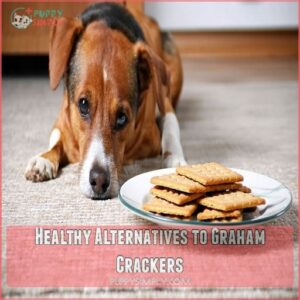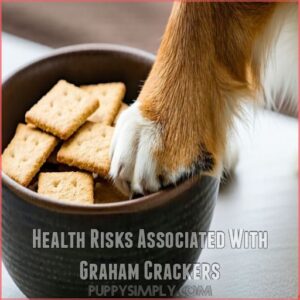This site is supported by our readers. We may earn a commission, at no cost to you, if you purchase through links.
 You might be wondering, can dogs eat graham crackers?
You might be wondering, can dogs eat graham crackers?
The short answer is yes, but in moderation.
While graham crackers won’t seriously harm your pup, they’re not the healthiest treat.
They’re high in sugar and carbs, which can lead to weight gain or upset stomachs if given too often.
So go ahead and let your dog have a nibble or two, but be mindful of portions.
And remember, there are plenty of tasty, dog-friendly alternatives out there that are better for their waistline and teeth.
Stay tuned to learn more about the dos and don’ts of feeding graham crackers to your furry friend.
Table Of Contents
- Key Takeaways
- Can Dogs Eat Graham Crackers?
- Are Graham Crackers Safe for Dogs?
- Types of Graham Crackers and Their Safety
- Graham Cracker Varieties to Avoid
- Healthy Alternatives to Graham Crackers
- Health Risks Associated With Graham Crackers
- How Many Graham Crackers Can Dogs Safely Eat?
- Before Sharing Graham Crackers With Your Dog
- Keeping Your Dog Healthy and Happy
- Frequently Asked Questions (FAQs)
- Are graham crackers bad for dogs?
- Are Graham crackers healthy to eat?
- Can dogs eat gluten-free graham crackers?
- Can you use graham crackers to train a dog?
- Can dogs eat crackers?
- Can dogs eat cinnamon graham crackers?
- What happens if your dog eats graham crackers?
- What kind of crackers can dogs eat?
- Do graham crackers contain xylitol?
- Are graham crackers safe?
- How do I introduce graham crackers to my dog safely?
- Are there any hidden dangers in graham cracker ingredients?
- How do I choose the best graham cracker brand for my dog?
- Can dogs with special dietary needs eat graham crackers?
- What are the best ways to monitor my dogs graham cracker intake?
- Conclusion
Key Takeaways
- Don’t worry; graham crackers won’t harm your dog, but they’re not a healthy choice due to high sugar and calorie content. Always keep portions small and occasional.
- Avoid varieties like chocolate or high-sugar options like Scooby Doo Grahams, as they’re potentially harmful to your pup’s health.
- Opt for healthy alternatives like sweet potato biscuits or fresh fruits and vegetables to provide nutritious, dog-friendly treats instead.
- Consult your vet before introducing new foods, especially if your dog has special dietary needs, to ensure a balanced and safe diet.
Can Dogs Eat Graham Crackers?
While these crunchy treats may be a favorite snack for some pups, it’s important to understand the potential risks.
Graham crackers aren’t considered a healthy option for canines, as they’re typically high in sugar and calories.
Moderation is key if you decide to share a bite or two.
But for the most part, it’s best to stick to dog-friendly treats specifically designed with your furry friend’s well-being in mind.
After all, your pup’s health should always come first.
Are Graham Crackers Safe for Dogs?
Graham crackers aren’t exactly the best snack for your furry friend.
Sure, they seem harmless with their sweet crunch, but they’ve got a high sugar content that spells trouble for dogs.
Think of them as the cookie aisle’s not-so-guilty pleasure that your pup should resist.
Instead, look for healthier pet treats designed for canine consumption.
Remember, keeping your dog healthy involves:
- Avoiding treats high in sugar and calories
- Watching out for xylitol dangers
- Considering dog allergies and dietary needs
A little caution keeps tails wagging!
Types of Graham Crackers and Their Safety
Not all graham crackers are created equal in terms of your pup’s health.
Some varieties are relatively safe in moderation.
Others are best avoided due to high sugar and calorie content.
Honey Graham Crackers
Honey graham crackers may not be the best choice for your pup.
While safe in small amounts, they’re high in sugar, which can lead to weight gain and other health issues over time.
Consider healthier dog treats like sweet potato biscuits or fresh fruits and veggies instead.
Monitor your dog closely when trying new foods.
Annie’s Organic Bunny Grahams
Despite being organic, Annie’s Bunny Grahams aren’t the healthiest option for your four-legged friend.
These graham crackers still pack a sugary punch:
- High in calories, which can lead to weight gain and obesity.
- Potential allergens like wheat flour may trigger reactions.
Better to stick with dog-safe treats like sweet potato biscuits or fresh veggies.
Honey Maid Graham Crackers
Regarding Honey Maid Graham Crackers, it’s important to remember their high sugar content.
While these crackers aren’t toxic to dogs, they’re far from ideal treats.
The excessive calories and sweetness can lead to weight gain, dental issues, and other health problems.
Consider healthier options like fresh fruits or vet-approved dog biscuits instead.
Keebler Grahams
Keebler Grahams aren’t quite the pot of gold for dog treats. Loaded with sugar and calories, these graham crackers can sneak up on your dog’s health like a sly fox. Moderation is key, or consider skipping them entirely for healthier options.
- Too much sugar
- Extra calories
- Sneaky ingredients
- Limited nutritional value
- Health risks for dogs
Nabisco Grahams
Nabisco Grahams pack a punch of sugar and calories that are best avoided for your pup.
These store-bought crackers are high in flour and refined sweeteners, which can pack on unwanted pounds and potentially lead to health issues.
Look for dog-friendly treats with less sugar and more natural ingredients to keep your canine companion happy and healthy.
Graham Cracker Varieties to Avoid
Certain graham cracker varieties like Scooby Doo Grahams and Teddy Grahams are big no-nos for your pup, thanks to their high sugar and calorie content.
Steer clear of chocolate-flavored graham crackers as well – the chocolate could make your furry friend sick.
Scooby Doo Graham Crackers
Scooby Doo Graham Crackers? Steer clear, pup parent.
Like animal crackers, which contain high sugar and salt risks, these crackers are loaded with sugar and calories – not a great treat for your canine compadre.
They may seem tempting, but too many could lead to some serious health woes down the road.
Let’s explore some healthier options that won’t pack on the pounds.
Teddy Grahams
Teddy Grahams may look cute, but they’re high in sugar and calories – not a healthy snack for your pup.
These bite-sized graham crackers can quickly pack on the pounds, leading to weight gain, diabetes, and other issues.
Instead, opt for low-calorie, low-sugar dog treats to satisfy their sweet tooth in a safer way.
Chocolate Graham Crackers
As tempting as chocolate might be, it’s a big no-no for your pup.
If you’re looking for a sweet treat, consider checking out chocolate graham crackers online, but remember to keep them out of reach of your furry friends.
Graham crackers with chocolate are toxic and can cause serious health issues.
Stick to dog-friendly treats like sweet potato biscuits or sweet fruit – your furry friend’s safety is what really matters.
Peanut Butter and Chocolate Filled Crackers
What about peanut butter and chocolate filled graham crackers?
Unfortunately, these are another variety you’ll want to avoid giving your pup.
The chocolate poses a serious health risk due to its toxicity, while the high sugar and calorie content can also cause issues.
Stick to plain graham crackers or explore homemade, dog-safe treats instead.
Healthy Alternatives to Graham Crackers
If you’re looking for healthy alternatives to graham crackers, why not try sweet potato biscuits or fresh fruits like zucchini, green beans, and carrots?
These canine-friendly treats are sure to satisfy your pup’s cravings without the extra sugar and calories.
Sweet Potato Biscuits
Sweet potato biscuits make a fantastic alternative to graham crackers.
They’re loaded with fiber, vitamins, and minerals that pups need without all the sugar.
You can whip up a batch at home using just a few wholesome ingredients, or explore pre-made options like those made from sweet potato dog treats.
Pups go wild for the sweet potato flavor and crunchy texture.
Plus, they’re way healthier than those store-bought treats.
Fresh Fruits
Looking for snack options? Fresh fruits are a great alternative to graham crackers! Dogs often enjoy them, but you’ve got to keep safety in mind.
Here’s a quick list:
- Apples – Remove seeds; they’re toxic.
- Bananas – A good source of potassium.
- Berries – Packed with antioxidants.
Just make sure your pup isn’t allergic.
Zucchini
Zucchini makes a fantastic alternative to traditional dog treats.
It’s packed with vitamins A and C, which support your pup’s vision and skin health.
Plus, the high water content helps with digestion.
Just slice it up into bite-sized pieces and watch your canine companion gobble it up with glee!
| Vegetable | Vitamin A | Vitamin C | Fiber | Water Content |
|---|---|---|---|---|
| Zucchini | High | High | Moderate | High |
| Carrots | Very High | Moderate | Moderate | Moderate |
| Green Beans | Moderate | High | High | Moderate |
| Sweet Potatoes | Very High | High | High | Moderate |
| Broccoli | Moderate | Very High | High | Moderate |
Green Beans
Green beans are a great alternative to graham crackers for your canine companion.
These crunchy veggies are low in calories, yet packed with fiber, vitamins, and minerals that can benefit your pup’s health.
Try:
- Steamed and cooled green beans as a tasty and hydrating treat
- Blending green beans into homemade dog food or treats
- Freezing puréed green beans into DIY dog popsicles
- Mixing diced green beans into your dog’s regular meals
Carrots
Carrots make a fantastic, healthy alternative to graham crackers for your canine companion.
Crunchy, vitamin-rich carrots can satisfy your dog’s natural chewing instincts while providing essential nutrients.
Slice up some fresh carrots or offer baby carrots as a low-calorie treat your pup is sure to love.
Just be mindful of portion sizes to avoid digestive upset.
Health Risks Associated With Graham Crackers
While graham crackers are generally safe for dogs in small amounts, they can pose some serious health risks.
Regularly feeding your pup these crunchy treats could lead to unwanted weight gain, tooth decay, and other concerning issues – so it’s best to be cautious about sharing your snacks.
Weight Gain and Obesity
Giving your pup too many graham crackers can quickly lead to unwanted weight gain and obesity, similar to how too many animal crackers can be problematic due to their high sugar and calorie content as seen with animal crackers.
These snacks are packed with calories and sugar that can pack on the pounds if not kept in check.
Stick to:
- Moderation – just a small crumb or two as a rare treat
- Healthier alternatives like sweet potato bites or fresh fruit
- Keeping an eye on their waistline and adjusting portions accordingly
Tooth Decay
In addition to weight gain and obesity, consuming too many graham crackers can also lead to tooth decay in dogs.
The high sugar content can promote plaque buildup and tartar formation, compromising your pup’s dental health.
To minimize this risk, consider using dog dental treats as a healthier alternative.
Regular teeth brushing and vet check-ups are essential to prevent costly oral issues down the road.
Allergic Reactions
On top of weight gain and tooth troubles, graham crackers can also trigger allergic reactions in some dogs.
Be on the lookout for signs like:
- Itchy, irritated skin
- Excessive scratching or licking
- Sneezing, coughing, or other breathing difficulties
If your pup shows these symptoms after eating graham crackers, check in with your vet right away.
High Sugar Content
Too much sugar in graham crackers can spell trouble for your pup.
The high calorie and carb content may cause a sugar rush, but it can also lead to weight gain, diabetes, and other health woes over time.
Look for low-sugar options or try natural alternatives like sweet potatoes or carrots instead.
| Nutrient | Graham Cracker | Healthy Treat |
|---|---|---|
| Sugar | High | Low |
| Calories | High | Moderate |
| Carbs | High | Moderate |
| Fat | Moderate | Low |
Moderation is key regarding feeding your dog human snacks.
Prioritize your pup’s wellbeing by offering healthy, dog-approved treats.
Limiting Mobility
While graham crackers may seem like an innocent treat, their high sugar content can actually limit your dog’s mobility.
Too many can contribute to weight gain, joint strain, and even arthritis over time.
Look for healthier, low-calorie options to keep your pup feeling spry and energized instead.
How Many Graham Crackers Can Dogs Safely Eat?
A few graham crackers here and there likely won’t do any harm, but you’ll want to keep a close eye on portions.
As a general rule, it’s best to limit human snack foods like saltine crackers, which are high in sodium and lack nutritional value canine snack safety guidelines.
Generally, no more than 1-2 small cracker pieces per day is recommended, and even that should be an occasional treat.
Avoid giving your pup too many, as the high sugar and calorie content can lead to weight gain, tooth decay, and other health issues over time.
Instead, opt for low-calorie, dog-friendly snacks like sweet potato bites or fresh fruits and veggies.
Before Sharing Graham Crackers With Your Dog
Before sharing your favorite graham crackers with your furry friend, it’s important to consult with your veterinarian.
Graham crackers, while they may seem harmless, can lead to some serious health concerns for your dog due to their high sugar and calorie content.
Consult a Veterinarian
Before letting your pup indulge, have a chat with your vet.
They’ll guide you on how many graham crackers are safe based on your dog’s size, age, and dietary needs.
Getting the green light from your trusted pet pro makes sure you’re keeping your four-legged friend happy and healthy.
Importance of a Balanced Diet
Balancing your dog’s diet isn’t just about avoiding canine obesity; it’s key to overall dog health.
A diverse menu meets their nutritional needs and keeps meals exciting.
Give thought to dog snacks and homemade dog treats that support their well-being.
Consider:
- Dog food brands that list quality ingredients.
- Monitor portions to prevent dog weight gain.
- Rotate flavors to maintain interest.
- Check labels for beneficial dog food ingredients.
Prioritizing Your Dog’s Well-being
At the end of the day, your pup’s well-being is paramount.
Before sharing those graham crackers, check in with your vet to make sure they align with your dog’s dietary needs.
After all, a healthy, happy hound is the ultimate goal – no matter the snack.
Keeping Your Dog Healthy and Happy
Keep your canine companion purring with joy by prioritizing their overall wellness.
Engage them in regular exercise, like brisk walks or playtime in the park, to maintain a healthy weight and strong muscles.
To find the perfect furry friend, consider researching friendly family dog breeds that fit your lifestyle and needs.
Groom them lovingly to promote a shiny coat and prevent matting.
Invest in enriching toys that stimulate their natural instincts and prevent boredom.
Most importantly, consult your vet to make sure your dog’s diet and nutrition align with their unique needs.
With a little TLC, you can keep your furry friend happy, healthy, and thriving.
Frequently Asked Questions (FAQs)
Are graham crackers bad for dogs?
While graham crackers aren’t toxic, they’re not the best treat for Fido.
Their high sugar and calorie content can lead to weight gain and other health issues.
Stick to dog-friendly snacks that won’t upset their tummy.
Are Graham crackers healthy to eat?
Imagine a bakery overflowing with tempting treats – that’s how graham crackers can seem.
But don’t be fooled, they’re not the healthiest snack, packed with sugar and calories that won’t do your body any favors.
Can dogs eat gluten-free graham crackers?
Dogs can enjoy gluten-free graham crackers in moderation.
It’s best to choose low-sugar options and avoid any with chocolate or xylitol.
Monitor for any allergic reactions.
And chat with your vet if you have questions.
Can you use graham crackers to train a dog?
Using graham crackers for dog training is like trying to bake a cake with just sugar—tempting but not ideal.
Rewards can occasionally work for training, but aim for healthier, dog-specific rewards to keep them motivated.
Can dogs eat crackers?
While the occasional cracker may not harm your pup, it’s best to stick to dog-safe treats.
Crackers are often high in calories, salt, and ingredients that can upset their tummy.
Play it safe and reach for healthier snacks designed just for canines.
Can dogs eat cinnamon graham crackers?
Cinnamon graham crackers are generally safe for dogs in small amounts.
They’re high in sugar and calories, so it’s best to avoid them.
Stick to dog-friendly treats to keep your pup healthy and happy.
What happens if your dog eats graham crackers?
Did you know dogs have a sweet tooth just like us?
While graham crackers may seem harmless, gobbling them up can lead to tummy troubles.
Stick to dog-approved treats to keep your furry friend happy and healthy.
What kind of crackers can dogs eat?
You’re in luck – many dog-safe crackers can satisfy your pup’s treat cravings.
Look for whole grain options low in sugar and fat, like whole wheat or oat crackers.
Just be sure to offer in moderation as part of a balanced diet.
Do graham crackers contain xylitol?
Let’s see, graham crackers don’t typically contain xylitol, that artificial sweetener that’s a big no-no for pups.
But it’s best to double-check the label just to be on the safe side, don’t you think?
Are graham crackers safe?
Graham crackers are generally safe for dogs in small amounts but aren’t a health food.
They can lead to weight gain.
Always dodge chocolate varieties and check for any allergic reactions.
How do I introduce graham crackers to my dog safely?
Forget the whole "forbidden fruit" thing.
Introduce tiny, plain bits—think crumbs, not a whole cracker.
Watch for tummy trouble.
A little goes a long way; moderation’s key.
Always consult your vet!
Are there any hidden dangers in graham cracker ingredients?
Watch out for chocolate, xylitol, and excess sugar in graham crackers.
These can be toxic or lead to health issues like obesity in dogs.
It’s like letting a kid loose in a candy store—tempting, but risky.
How do I choose the best graham cracker brand for my dog?
Choose graham crackers that are low in sugar and calories, avoiding those with chocolate or xylitol.
Opt for plain or honey varieties and give them sparingly.
Moderation is key. Your dog’s health deserves better treats.
Can dogs with special dietary needs eat graham crackers?
Dogs with special dietary needs should avoid graham crackers due to high sugar and calorie content.
Dog-specific treats that cater to their dietary restrictions are a better option.
Always consult your vet before introducing new snacks into their diet.
What are the best ways to monitor my dogs graham cracker intake?
Keep track by limiting portions to occasional treats, using post-snack mini weigh-ins for hints of doggy weight gain.
Sneak in humor—"You ate all the crumbs!"—to ease any guilt while staying alert for allergies.
Conclusion
So, you’re wondering, can dogs eat graham crackers?
It’s like asking if you can survive on cupcakes. Sure, it’s possible, but it’s not ideal.
Graham crackers are okay for an occasional nibble, but they shouldn’t form a staple of your dog’s diet.
Keep their health in mind—just like you skip dessert when you’re full, your pup should enjoy healthier treats more often.
Consult your vet if unsure, and let’s keep those tails wagging!
- https://www.entrepreneur.com/living/the-seriously-unsexy-origins-of-the-graham-cracker/252725
- https://www.wellnesspetfood.com/
- https://www.vetstreet.com/food-and-treats/dog-treats/best-dog-treats
- https://thecottagemarket.com/quick-and-easy-dog-graham-cracker-treats/
- http://www.gonetothesnowdogs.com/diygrahamcrackersfordogs/





















